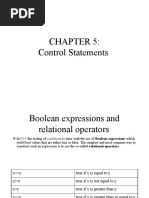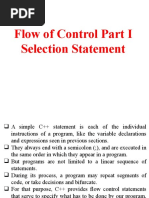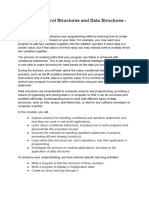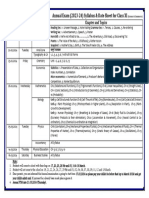Computer Programming 04
Uploaded by
Salman shakeelComputer Programming 04
Uploaded by
Salman shakeelCOMPUTER
PROGRAMMING
Lecture 04
Switch Multiple Selection Structure
While Repetition Structure
Dr. Muniba Ashfaq
TODAY’S AGENDA
Switch Multiple Selection Structure
Syntax
Flowchart
Examples
While Repetition Structure
Syntax
Flowchart
Examples
Nested Control Structure
Example
Dr. Muniba Ashfaq
THE SWITCH MULTIPLE-SELECTION
STRUCTURE
Switch is typically a selection structure and an alternative to the long string
of ifs
Tests variables for multiple values
Consists of a series of case labels and an optional default case
General format
switch ( variable ) {
case value1: // taken if variable == value1
statements
break; // necessary to exit switch
case value2:
case value3: // taken if variable == value2 or == value3
statements
break;
default: // taken if variable matches no other cases
statements
break;
}
Dr. Muniba Ashfaq
THE SWITCH MULTIPLE-SELECTION
STRUCTURE
Expression (variable in braces after switch)
must be of type integer or character. It is the
controlling expression of switch statement
The keyword case must be followed by a
constant
break statement is required unless you want all
subsequent statements to be executed.
Dr. Muniba Ashfaq
RULES
The following rules apply to a switch
statement:
You can have any number of case statements
within a switch. Each case is followed by the
value to be compared to and a colon.
The constant-expression for a case must be
the same data type as the variable in the
switch.
Dr. Muniba Ashfaq
RULES CONTD..
When the variable being switched on is
equal to a case, the statements following
that case will execute until a break
statement is reached
When a break statement is reached, the
switch terminates, and the flow of control
jumps to the next line following the switch
statement
Dr. Muniba Ashfaq
RULES CONTD..
Not every case needs to contain a break. If
no break appears, the flow of control
will fall through to subsequent cases until
a break is reached
A switch statement can have an
optional default case, which must appear
at the end of the switch. The default case
can be used for performing a task when
none of the cases is true. No break is
needed in the default case
Dr. Muniba Ashfaq
EXAMPLE
#include <iostream>
using namespace std;
int main ()
{
char grade = 'D'; // local variable declaration:
switch(grade)
{
case 'A' :
cout << "Excellent!" << endl;
break;
case 'B' :
case 'C' :
cout << "Well done" << endl;
break;
case 'D' :
cout << "You passed" << endl; break;
case 'F' :
cout << "Better try again" << endl;
break;
default :
cout << "Invalid grade" << endl; }
cout << "Your grade is " << grade << endl;
return 0; } Dr. Muniba Ashfaq
OUTPUT
This would produce the following
result:
You passed
Your grade is D
Dr. Muniba Ashfaq
REVIEWING CHARACTER
DATA TYPE
As we know a computers can process character data too
char
Short for character
Can be any single character from the keyboard
To declare a variable of type char:
char letter;
Character constants are enclosed in single quotes
char letter = 'a';
Strings of characters, even if only one character
is enclosed in double quotes
"a" is a string of characters containing one character
'a' is a value of type character
Dr. Muniba Ashfaq
CHAR INT
It is possible to store char values in integer variables (an important feature of c++)
Characters are represented as 1-byte integer in computers so we can treat a
character as either char or int depending on its use
int value = ‘A'; //65 is ASCII for A
value will contain an integer representing 'A‘ i.e. value = 65
Similarly
It is possible to store int values in char variables
char letter = 97; //97 is numerical representation of lower case a (ASCII)
Result of the above statement is letter = a
Use single quotes to get numerical representation of a character
cout << "The character (" << 'a' << ") has the value "
<< ( int ) ( 'a' ) << endl;
Prints
The character (a) has the value 97
ASCII (American Standard Code For Information Interchange)
Dr. Muniba Ashfaq
COMPARING IF/ELSE WITH SWITCH WITH THE HELP OF
AN EXAMPLE
•When you want to create different outcomes depending on specific
values, you can use a series of ifs.
Dr. Muniba Ashfaq
COMPARING IF/ELSE WITH SWITCH WITH THE HELP OF
AN EXAMPLE
However, as an alternative to the long string of ifs, you can use the switch statement
Department is the control variable and is integer
Compare the department to cases and prints the department it matches.
Removing break changes behavior of
statement.
It causes switch statement to end.
Dr. Muniba Ashfaq
REPETITION STRUCTURES
Many application require certain operations to be carried out more than once. Such
situations require repetition in control flow.
C++ has three types while, do/while, for
while Repetition Structure
Action repeated while some condition remains true.
When an action must be repeated a loop is used.
While loop syntax
while (boolean expression is true)
{
statements to repeat ; //braces are required for compound statement.
}
While (boolean expression is true)
statement to repeat; // no braces are required for single statement
Dr. Muniba Ashfaq
WHILE STATEMENT
SYNTAX
Dr. Muniba Ashfaq
WHILE REPETITION
STRUCTURE
Flow chart
no
condition
yes
Statements in
Loop body
Dr. Muniba Ashfaq
WHILE LOOP OPERATION
First, the condition is evaluated
If true, the body of the loop is executed and the control is transferred back
to the condition for re-evaluation
During execution, some item from the boolean expression
is changed
If false, the while loop is exited and control is transferred to the statement
after the while loop body.
A while loop might not execute at all if the
boolean expression is false on the first check
Dr. Muniba Ashfaq
EXAMPLE:
#include <iostream>
using namespace std;
int main ()
{ // Local variable declaration:
int a = 10;
// while loop execution
while( a < 20 )
{
cout << "value of a: " << a << endl;
a++; }
return 0;
}
Dr. Muniba Ashfaq
OUTPUT
When the above code is compiled and executed, it
produces the following result:
value of a: 10
value of a: 11
value of a: 12
value of a: 13
value of a: 14
value of a: 15
value of a: 16
value of a: 17
value of a: 18
value of a: 19
Dr. Muniba Ashfaq
WHILE REPETITION STRUCTURE
Psuedocode example
while there are more items on my shopping list
Purchase next item and cross it off my list
while loop repeated until condition becomes false
Condition there are more items on my shopping list is either true or false.
If true, the action “Purchase next item and cross it off my list” is performed.
The action will be performed repeatedly while the condition remains true.
The condition will become false when the last item on the list is purchased and
crossed of the list. The repetition will terminate.
Then the first statement after the repetition structure is executed.
Dr. Muniba Ashfaq
WHILE REPETITION
STRUCTURE
Example statement
Consider a program segment designed to find the first power of 2 larger
than 1000.
Suppose the integer variable product has been initialized to 2.
When wile repetition structure finishes executing.
Product will contain the desired answer.
Lets observe the flow chart and the c++ code.
Dr. Muniba Ashfaq
WHILE REPETITION
STRUCTURE
Flow chart
true
product <= 1000 product = 2 * product
false
C++ Code
int product = 2;
while ( product <= 1000 )
product = 2 * product;
Dr. Muniba Ashfaq
EXPLANATION
In the previous example the value of product is 2 when the while
structure is entered.
The variable product is repeatedly multiplied by 2, taking values
4, 8, 16, 32, 64, 128, 256, 512, 1024.
At product = 1024 the while structure condition product<=1000,
becomes false.
This terminates the repetition.
Observe that the final value of product is 1024.
Dr. Muniba Ashfaq
EXAMPLE TO PRINT GREETINGS USING WHILE
REPETITION STRUCTURE
1. //a while loop example
2. //program to print the hello greetings
3. //user give the number of times hello greeting to be printed.
4. #include <iostream.h>
5. int main()
6. {
7. int count_down; //declaring count_down as an integer variable
8. cout<<"How many greetings do u want\n"; //prompt user to enter the number for greetings
9. cin>>count_down; //reading value this value gives number of times greeting will appears
10. while(count_down > 0) //while loop condition, if countdown is greater than zero
11. {
12. cout<<"HELLO!\t"; //printing hello
13. count_down = count_down - 1; //decrementing the value in count_down (counter) by 1
14. } //while body ends here
15. cout<<endl;
16. cout<<"thats all \n"<<"have a great day";
17. return 0;
18. }
Dr. Muniba Ashfaq
OUT PUT FOR TWO DIFFERENT INPUTS
Input = 5
Printing hello 5 times
Input = 7
Printing hello 7 times
Dr. Muniba Ashfaq
COUNTER CONTROL
REPETITION
Loop is repeated until counter reaches certain value.
Number of repetitions known before the loop begins executing
(Definite repetition).
Counter variables should be initialized before the loop begins.
An uninitialized counter may contain a garbage (undefined)
value and the result of the program could be incorrect (LOGIC
ERROR).
Counter variables are normally initialized to zero or one,
depending on their use.
Dr. Muniba Ashfaq
ESSENTIALS OF COUNTER-CONTROLLED
REPETITION
Counter-controlled repetition requires
Name of control variable/loop counter
Initial value of control variable
Condition to test for final value
Increment/decrement to modify control variable when looping
Dr. Muniba Ashfaq
COUNTER CONTROL
REPETITION
//Consider a simple example to understand counter
controlled //repetition structure.
1. //print 1 to 100 using a while loop
2. #include <iostream.h>
3. int main()
4. {
5. int count; //declaration of control variable count
6. count=1; //initialization of control variable
7. while (count<=100) //while count is less than 100 program will print the count
8. {
9. cout<<count<<“\t”;
10. count=count+1 //add one to the count every time the loop repeats.
11. } /*when count is greater than 100 then the loop will
12. terminate and the statement next to the while loop will execute*/
13. Return 0; //indicated successful termination
14. } //end of function main
Dr. Muniba Ashfaq
OUTPUT
Dr. Muniba Ashfaq
C++ CODE
1. // example
2. // Class average program with counter-controlled repetition.
3. #include <iostream.h>
4. // function main begins program execution
5. int main()
6. {
7. int total; // sum of grades input by user
8. int gradeCounter; // number of grade to be entered next
9. int grade; // grade value
10. int average; // average of grades
11.
12. // initialization phase
13. total = 0; // initialize total
14. gradeCounter = 1; // initialize loop counter
15.
Dr. Muniba Ashfaq
C++ CODE
21 // processing phase
22 while ( gradeCounter <= 10 ) { // loop 10 times
23 cout << "Enter grade: "; // prompt for input
24 cin >> grade; // read grade from user
25 total = total + grade; // add grade to total
26 gradeCounter = gradeCounter + 1; // increment counter
27 }
28
29 // termination phase
30 average = total / 10; // integer division
31
The counter gets incremented each
32 // display result
time the loop executes.
33 cout << "Class average is " << average << endl;
Eventually, the counter causes the
34 loop to end.
35 return 0; // indicate program ended successfully
36
37 } // end function main
38 //observe the output on next slide
Dr. Muniba Ashfaq
OUTPUT
•Note that total is 723
•Average = 723 / 10 = 72.3(floatin point number)
•Program produce an integer result 72,
•because average is identified as integer type
•To deal with such situation we use the explicit
conversion which we will discuss latter.
Dr. Muniba Ashfaq
SENTINEL-CONTROLLED
REPETITION
Also called indefinite repetition.
The number of repetitions is not known before the loop begins executing.
unknown number of inputs to the loop.
Requires a sentinel value (to indicate end of data entry) to quit the loop.
Sentinel value
Also called dummy value, signal value or a flag value.
Indicates “end of data entry”
Loop ends with sentinel input
Sentinel value should be chosen so that it cannot be confused with an
acceptable data value.
For example (-1) in case of grade example.
As -1 is not going to be any grade (grade is only + value) so
this can be used to quit the loop.
Dr. Muniba Ashfaq
C++ CODE
1 // grade example for sentinel controlled repitition
2 // Class average program with sentinel-controlled repetition.
3 #include <iostream.h>
4
10 #include <iomanip.h> // parameterized stream manipulators
11
12
13
14 // function main begins program execution
15 int main()
16 {
17 int total; // sum of grades Data type double used to represent
18 int gradeCounter; // number of gradesdecimal
enterednumbers.
19 int grade; // grade value
20
21 double average; // number with decimal point for average
22
23 // initialization phase
24 total = 0; // initialize total
25 gradeCounter = 0; // initialize loop counter
Dr. Muniba Ashfaq
C++ CODE
26
27 // processing phase
28 // get first grade from user
29 cout << "Enter grade, -1 to end: "; // prompt for input
30 cin >> grade; // read grade from user
31
32 // loop until sentinel value read from user
33 while ( grade != -1 ) {
34 total = total + grade; // add grade to total
35 gradeCounter = gradeCounter + 1; // increment counter
36
37 cout << "Enter grade, -1 to end: "; // prompt for input
38 cin >> grade; // read next grade •As dividing two integers truncates the remainder, to deal
39 with it unary cast operator is used. Its general form is
40 } // end while <type>(operand)
41 •<float>(total)is used in this program. It creates a temporary
42 // termination phase floating point copy of operand in the parenthesis.
•Here it treats total as a float temporarily (casting).
43 // if user entered at least one grade ... producing a floating point calculation with integer values.
44 if ( gradeCounter != 0 ) { •. Using cast operator in this manner is called explicit
45 conversion.
46 // calculate average of all grades entered •gradeCounter is an int, but it gets promoted to float by the
47 average = <float >( total ) / gradeCounter;
compiler implicitly for the calculation purpose.
Dr. Muniba Ashfaq
setprecision(2)prints two digits past
C++ CODE decimal point (rounded to fit precision).
49 // display average with two digits of precision
Programs that use this must include
50 cout << "Class average is " << setprecision( 2 )
<iomanip.h>
51 << fixed << average << endl;
52
53 } // end if part of if/else
54
55 else // if no grades were entered, output appropriate message
56 cout << "No grades were entered" << endl; fixed forces output to print
57 in fixed point format (not
58 return 0; // indicate program ended successfully scientific notation). Also,
59 forces trailing zeros and
60 } // end function main decimal point to print.
Include <iostream>
Dr. Muniba Ashfaq
OUTPUT
Notice -1 (sentinel value) indicating
the end of the data entry.
Dr. Muniba Ashfaq
You might also like
- Decisions and Loops - Introduction To Pre-Defined FunctionsNo ratings yetDecisions and Loops - Introduction To Pre-Defined Functions33 pages
- Control Structures in C++: While, Do/while, For Switch, Break, ContinueNo ratings yetControl Structures in C++: While, Do/while, For Switch, Break, Continue38 pages
- Control Structures: Introduction To Computer ScienceNo ratings yetControl Structures: Introduction To Computer Science37 pages
- Data Structures and Object Oriented Programming in C++No ratings yetData Structures and Object Oriented Programming in C++60 pages
- Chapter 3 Contol and Desicion (Autosaved)No ratings yetChapter 3 Contol and Desicion (Autosaved)48 pages
- Hsslive Xii Comp Ch 1 Review of c++ Programming UptNo ratings yetHsslive Xii Comp Ch 1 Review of c++ Programming Upt30 pages
- Decisions and Loops - Introduction To Pre-Defined FunctionsNo ratings yetDecisions and Loops - Introduction To Pre-Defined Functions32 pages
- 3 Conditional Evaluation of Code: 3.1 Flow ControlNo ratings yet3 Conditional Evaluation of Code: 3.1 Flow Control27 pages
- Control Structures and Data Structures INo ratings yetControl Structures and Data Structures I21 pages
- Selection Structures: Programming Fundamentals 1No ratings yetSelection Structures: Programming Fundamentals 137 pages
- DFC20113 - CHAPTER 3 (PROGRAM CONTROL STRUCTURES)No ratings yetDFC20113 - CHAPTER 3 (PROGRAM CONTROL STRUCTURES)46 pages
- Fundamentals of Programming: Chapter 3: Control StructureNo ratings yetFundamentals of Programming: Chapter 3: Control Structure42 pages
- Repetition Structures, or Loops, Are Used When A Program Needs To Repeatedly Process One orNo ratings yetRepetition Structures, or Loops, Are Used When A Program Needs To Repeatedly Process One or15 pages
- Repetition Structures: Programming Fundamentals 1No ratings yetRepetition Structures: Programming Fundamentals 158 pages
- Control Structure - If Else and Switch in C++ Programming100% (1)Control Structure - If Else and Switch in C++ Programming27 pages
- Hsslive Xi Comp App Unit Notes CH 4 To 7 Eng Act MLPMNo ratings yetHsslive Xi Comp App Unit Notes CH 4 To 7 Eng Act MLPM4 pages
- The Result of The Assignment #1: C++ Language Control StatementNo ratings yetThe Result of The Assignment #1: C++ Language Control Statement14 pages
- BE EXPERT IN JAVA Part- 2: Learn Java programming and become expertFrom EverandBE EXPERT IN JAVA Part- 2: Learn Java programming and become expertNo ratings yet
- Raychem Screened Elbow/Straight Separable Connectors Rses/RsssNo ratings yetRaychem Screened Elbow/Straight Separable Connectors Rses/Rsss2 pages
- 14 - GoGetter L1 TB Skills Revision 7and8No ratings yet14 - GoGetter L1 TB Skills Revision 7and82 pages
- Formulation and Evaluation of Niosomal in Situ GelNo ratings yetFormulation and Evaluation of Niosomal in Situ Gel14 pages
- R. K. Educational School: Annual Exam (2023-24) Syllabus & Date Sheet For Class XINo ratings yetR. K. Educational School: Annual Exam (2023-24) Syllabus & Date Sheet For Class XI1 page
- NDA NA National Defence Academy Naval Academy Entrance Examination Mathematics Chapterwise Previous Years 3000 Objective Questions Manjul Tyagi100% (6)NDA NA National Defence Academy Naval Academy Entrance Examination Mathematics Chapterwise Previous Years 3000 Objective Questions Manjul Tyagi62 pages
- LAAA Datasheet (Low) LG All-In-One Smart LED 240311 (20240311 180902)No ratings yetLAAA Datasheet (Low) LG All-In-One Smart LED 240311 (20240311 180902)8 pages
- Timber Beam Analysis & Design To Bs5268-2:2002: Project Job NoNo ratings yetTimber Beam Analysis & Design To Bs5268-2:2002: Project Job No3 pages
- Mechanical Advantage and Simple Machines.pptxNo ratings yetMechanical Advantage and Simple Machines.pptx89 pages
- Access Structures 7th Edition Schodek Solutions Manual All Chapters Immediate PDF Download100% (7)Access Structures 7th Edition Schodek Solutions Manual All Chapters Immediate PDF Download35 pages
- Decisions and Loops - Introduction To Pre-Defined FunctionsDecisions and Loops - Introduction To Pre-Defined Functions
- Control Structures in C++: While, Do/while, For Switch, Break, ContinueControl Structures in C++: While, Do/while, For Switch, Break, Continue
- Control Structures: Introduction To Computer ScienceControl Structures: Introduction To Computer Science
- Data Structures and Object Oriented Programming in C++Data Structures and Object Oriented Programming in C++
- Hsslive Xii Comp Ch 1 Review of c++ Programming UptHsslive Xii Comp Ch 1 Review of c++ Programming Upt
- Decisions and Loops - Introduction To Pre-Defined FunctionsDecisions and Loops - Introduction To Pre-Defined Functions
- 3 Conditional Evaluation of Code: 3.1 Flow Control3 Conditional Evaluation of Code: 3.1 Flow Control
- Fundamentals of Programming: Chapter 3: Control StructureFundamentals of Programming: Chapter 3: Control Structure
- Repetition Structures, or Loops, Are Used When A Program Needs To Repeatedly Process One orRepetition Structures, or Loops, Are Used When A Program Needs To Repeatedly Process One or
- Control Structure - If Else and Switch in C++ ProgrammingControl Structure - If Else and Switch in C++ Programming
- Hsslive Xi Comp App Unit Notes CH 4 To 7 Eng Act MLPMHsslive Xi Comp App Unit Notes CH 4 To 7 Eng Act MLPM
- The Result of The Assignment #1: C++ Language Control StatementThe Result of The Assignment #1: C++ Language Control Statement
- BE EXPERT IN JAVA Part- 2: Learn Java programming and become expertFrom EverandBE EXPERT IN JAVA Part- 2: Learn Java programming and become expert
- Raychem Screened Elbow/Straight Separable Connectors Rses/RsssRaychem Screened Elbow/Straight Separable Connectors Rses/Rsss
- Formulation and Evaluation of Niosomal in Situ GelFormulation and Evaluation of Niosomal in Situ Gel
- R. K. Educational School: Annual Exam (2023-24) Syllabus & Date Sheet For Class XIR. K. Educational School: Annual Exam (2023-24) Syllabus & Date Sheet For Class XI
- NDA NA National Defence Academy Naval Academy Entrance Examination Mathematics Chapterwise Previous Years 3000 Objective Questions Manjul TyagiNDA NA National Defence Academy Naval Academy Entrance Examination Mathematics Chapterwise Previous Years 3000 Objective Questions Manjul Tyagi
- LAAA Datasheet (Low) LG All-In-One Smart LED 240311 (20240311 180902)LAAA Datasheet (Low) LG All-In-One Smart LED 240311 (20240311 180902)
- Timber Beam Analysis & Design To Bs5268-2:2002: Project Job NoTimber Beam Analysis & Design To Bs5268-2:2002: Project Job No
- Access Structures 7th Edition Schodek Solutions Manual All Chapters Immediate PDF DownloadAccess Structures 7th Edition Schodek Solutions Manual All Chapters Immediate PDF Download

























































































